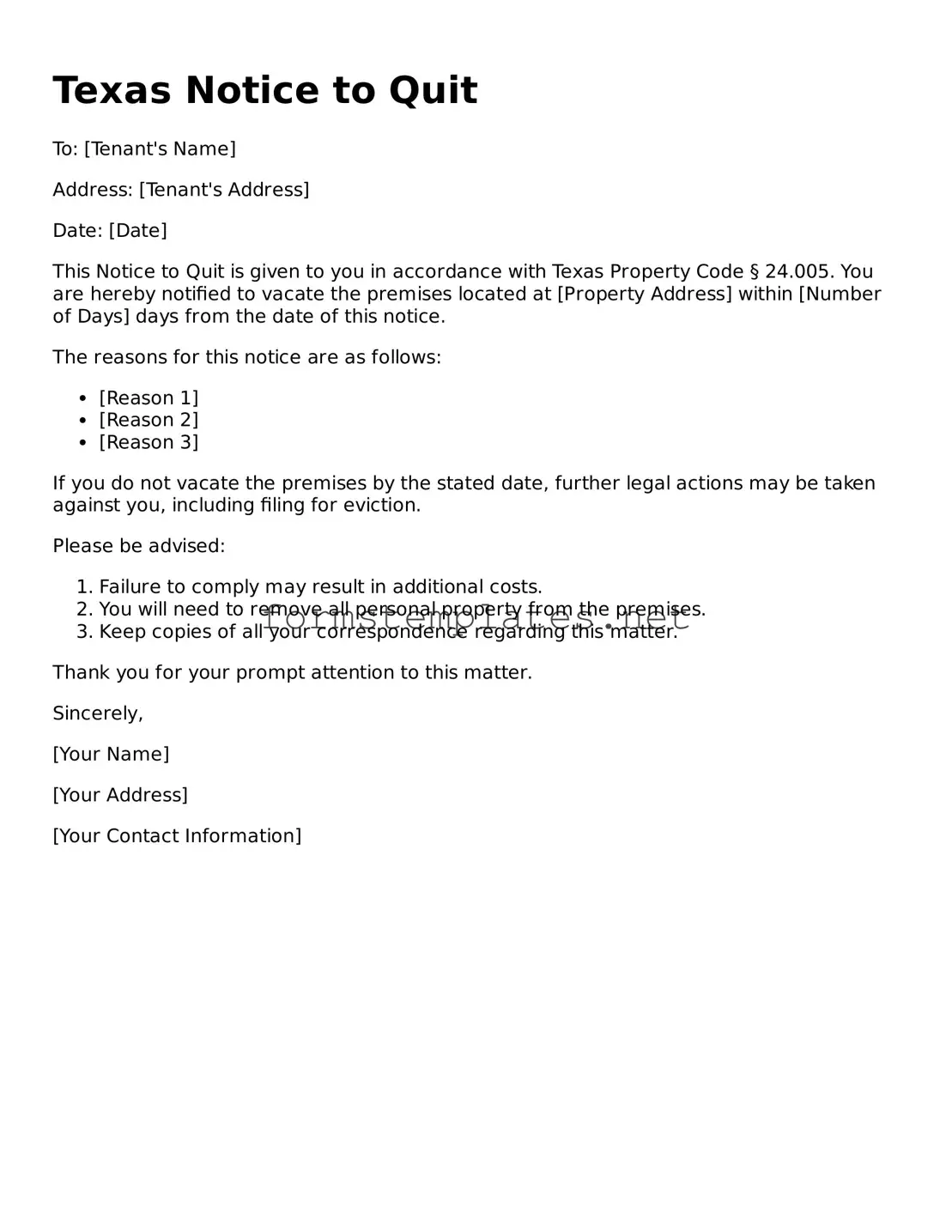The Texas Notice to Quit form is a legal document used by landlords to formally notify tenants that they must vacate the rental property. This notice is typically issued when a tenant has violated the terms of their lease or has failed to pay rent. It serves as a preliminary step before any legal eviction proceedings can begin.
When should a landlord use a Notice to Quit?
A landlord should use a Notice to Quit when a tenant has not complied with the lease agreement. Common situations include:
-
Failure to pay rent on time.
-
Violation of lease terms, such as unauthorized pets or excessive noise.
-
Engaging in illegal activities on the premises.
It is important to note that a Notice to Quit is not required in every circumstance, but it is a best practice to provide tenants with an opportunity to remedy the situation before pursuing eviction.
How much notice must be given in a Texas Notice to Quit?
The amount of notice required can vary depending on the reason for the eviction. Generally, landlords must provide:
-
Three days' notice for non-payment of rent.
-
Ten days' notice for lease violations that can be corrected.
-
Thirty days' notice for month-to-month tenants without a specific lease violation.
These timeframes allow tenants a chance to address the issue before legal action is taken.
Can a tenant contest a Notice to Quit?
Yes, a tenant has the right to contest a Notice to Quit. If a tenant believes the notice is unjust or that they have rectified the situation, they can communicate with the landlord. If the dispute escalates, it may lead to a court hearing where both parties can present their cases.
What happens if a tenant does not comply with the Notice to Quit?
If a tenant does not comply with the Notice to Quit, the landlord may proceed with eviction proceedings. This typically involves filing a lawsuit in the local justice court. The court will then schedule a hearing where both the landlord and tenant can present their arguments. If the court rules in favor of the landlord, a judgment for eviction will be issued.
Is a Notice to Quit the same as an eviction notice?
No, a Notice to Quit is not the same as an eviction notice. The Notice to Quit serves as a preliminary warning to the tenant, while an eviction notice is a formal legal document that follows if the tenant fails to vacate the property after receiving the Notice to Quit. The eviction notice initiates the legal process to remove the tenant from the property.
What should be included in a Texas Notice to Quit?
A Texas Notice to Quit should include several key elements to ensure it is legally valid:
-
The date of the notice.
-
The tenant's name and address of the rental property.
-
The reason for the notice (e.g., non-payment of rent).
-
The specific timeframe in which the tenant must vacate.
-
The landlord's contact information.
Including these details helps to clarify the situation and provides a clear record of communication.
Can a Notice to Quit be delivered electronically?
In Texas, a Notice to Quit must typically be delivered in person or sent via certified mail. While electronic delivery methods may be convenient, they do not always meet legal requirements. It is advisable for landlords to stick to traditional methods to ensure compliance with state laws.
What are the consequences of not using a Notice to Quit?
Failing to use a Notice to Quit can complicate the eviction process. If a landlord skips this step, they may face challenges in court. A judge may dismiss the eviction case if proper notice was not given. Thus, using a Notice to Quit is crucial for landlords to protect their legal rights and streamline the eviction process.
